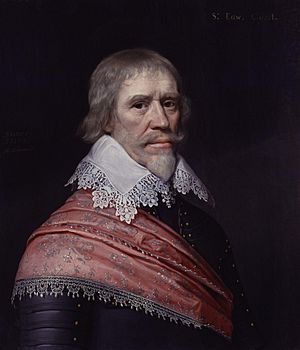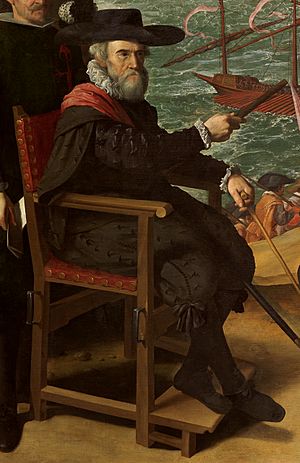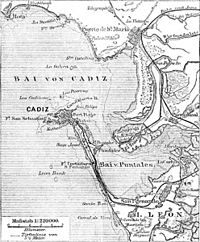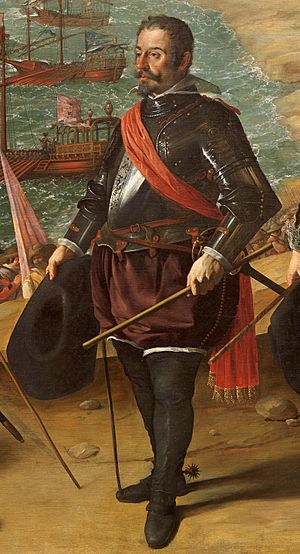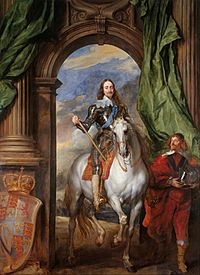Cádiz expedition (1625) facts for kids
Quick facts for kids Cádiz expedition (1625) |
|||||||
|---|---|---|---|---|---|---|---|
| Part of the Anglo-Spanish War and the Thirty Years' War | |||||||
 The Defence of Cádiz against the English Francisco de Zurbarán, 1634. |
|||||||
|
|||||||
| Belligerents | |||||||
| Commanders and leaders | |||||||
| Strength | |||||||
| 5,400 sailors 10,000 soldiers 105 ships |
4,000 men in Cádiz 2,300 men in bridge Zuazo |
||||||
| Casualties and losses | |||||||
| 7,000 dead or captured 62 ships lost |
Low | ||||||
The Cádiz expedition of 1625 was a naval attack by England and the Netherlands against Spain. It happened during the Anglo-Spanish War and the Thirty Years' War. The goal was to capture Spanish treasure ships and attack Spanish cities. This would weaken Spain's power and resources.
Contents
Why the Expedition Happened
After some disagreements, Prince Charles and the Duke of Buckingham wanted to go to war with Spain. They convinced King James to ask Parliament for advice. Parliament agreed that war with Spain was a good idea.
However, King James worried that Parliament would not pay for the war. Parliament worried that the King would not fight if they gave him money. King James died soon after. His son, Charles, became king. Charles thought Parliament would pay for the war since they wanted it.
The Plan
War was declared on Spain. The Duke of Buckingham started getting ready for the attack. The plan had two main parts. First, they wanted to capture Spanish ships bringing gold and silver from the Americas. Second, they aimed to attack Spanish towns. This would hurt Spain's economy and its ability to fight.
The Expedition Begins
By October 1625, about 100 ships and 15,000 sailors and soldiers were ready. England also made an alliance with the Dutch. The Dutch sent 15 warships to help protect the English Channel. Sir Edward Cecil was chosen to lead the expedition. He was a good soldier but did not know much about naval warfare. This choice was not the best.
The expedition left Plymouth Sound on October 6, 1625. The journey was very difficult. Storms damaged many ships and caused long delays. By the time the fleet reached Spanish waters, they were low on supplies. They had also missed the Spanish treasure fleet. The treasure ships had taken a different, safer route.
Attacking Cádiz
Cecil decided to attack the Spanish city of Cádiz. His forces landed in the Bay of Cádiz. They managed to capture the fort that guarded the harbor. But the city itself was strongly defended with modern forts. Cecil then started making big mistakes. Spanish ships that could have been captured escaped. Most of Cecil's forces waited for orders and did not act. The Spanish ships sailed to safety in Puerto Real.
Many of the English ships were merchant vessels. They had been changed to fight in the war. The captains of these ships were worried about their own vessels. They left much of the fighting to the Dutch ships.
Capturing the El Puntal tower was also a mistake. This fort did not need to be taken to attack Cádiz.
When Cecil's soldiers landed, they realized they had no food or water. Cecil made a poor choice. He allowed the men to drink from wine barrels they found. Many soldiers became disorganized and unable to fight effectively. Realizing his mistake, Cecil ordered his men to return to their ships and retreat.
Failed Treasure Hunt
After the embarrassing failure at Cádiz, Cecil tried another plan. He wanted to stop a fleet of Spanish galleons. These ships were bringing valuable resources from the New World. This plan also failed. The Spanish ships had been warned of danger. They took another route and returned home safely.
Returning Home
Sickness was spreading among the soldiers. The ships were also in bad condition. Cecil finally decided there was no other choice but to return to England. He had captured very little and had little impact on Spain. In December, the fleet returned home. The expedition had cost England about £250,000.
What Happened Next
The failed attack caused big problems in England. King Charles I wanted to protect his own reputation. He also wanted to protect his friend, Buckingham. Buckingham should have made sure the ships were well supplied. But Charles did not ask why the expedition failed. Instead, he focused on helping the Huguenots in La Rochelle.
The House of Commons (part of Parliament) was not as forgiving. In 1626, Parliament started a process to remove Buckingham from his position. To stop this, King Charles chose to end Parliament.
See also
 In Spanish: Defensa de Cádiz (1625) para niños
In Spanish: Defensa de Cádiz (1625) para niños
- Annus mirabilis
Sources
Roger Manning, Oxford (2006), An Apprenticeship in Arms: The Origins of the British Army 1585–1702


